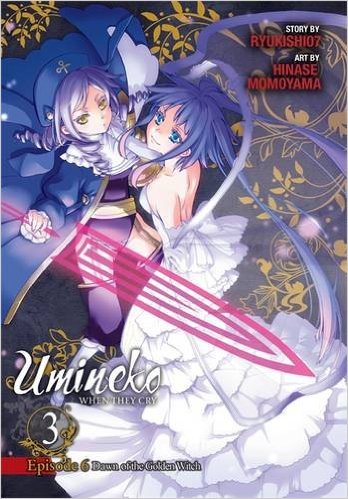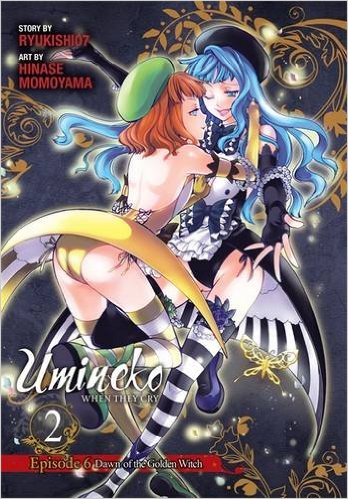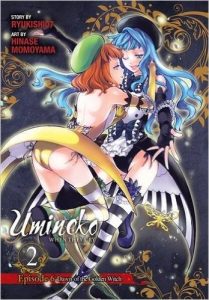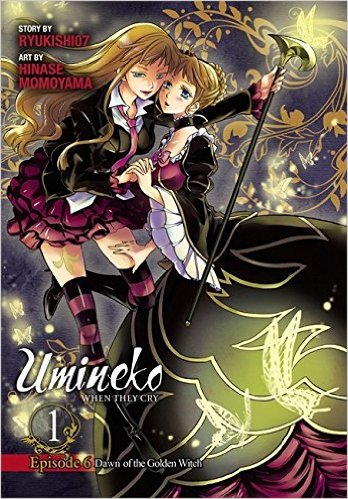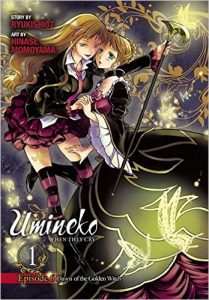Story by Ryukishi07; Art by Hinase Momoyama. Released in Japan in two separate volumes as “Umineko no Naku Koro ni: Dawn of the Golden Witch” by Square Enix, serialized in the magazine GFantasy. Released in North America by Yen Press. Translated by Stephen Paul.
Warning: this reviews mentions the biggest spoiler in Umineko, which I have been dancing around until now. I won’t mention it in this first paragraph, but it’s hard not to review this final omnibus of the arc and discuss it, as it ends up being a major part of the climax. Before we get to that, though: I’ve talked before about how Ryukishi07 loves a good old fashioned shonen battle at heart, and a great deal of this book is just that. Various characters try to attack Beatrice and get blown away by various other characters, as you realize how ridiculously huge the cast has become by now. Erika finally loses, and judging by the “roll call” at the end of the book, seemingly abandoned to a watery grave by Bernkastel. And Ryukishi still can’t resist connecting Umineko and Higurashi, even though Featherine and Hanyuu are as alike as two very unalike things.
(I am very irritated with that front cover image, by the way. I know it’s not Yen’s fault, and that the Japanese licensor chose which cover to use and which to hide. But it makes me sad that the best cover in the series is relegated to the color page inside.)
For those trying to figure out what’s going on in Umineko, the manga has been a bit more obvious in its hints than the visual novel, even back in earlier arcs. For this particular arc, we’ve spent a long time debating why it is that Shannon, Kanon, and Beatrice need magic in order to have their love fulfilled, and this volume explicitly says it’s because they are not a whole person. Meanwhile, as predicted in the last volume, Battler is trapped in a logic error of his own making, trapped inside the guest room till he can figure out how to get out without disturbing the chain lock, duct tape seals, or anything else. The answer ends up being that Kanon, being dead (Shannon won the big duel), can now come free Battler and take his place. And then “erase himself” by magic. There’s only one way for this all to work, and that’s by realizing that we’re talking about IDENTITIES when we discuss people on the island, not BODIES. Shannon and Kanon cannot both love without magic help as they’re the same person. And both are also a third person – Beatrice.
This works a lot better than you’d imagine if you think about what is “real” in the books and what takes place in an imaginary fantasy world. We’ve gone on and on about “magic” being a conceit, and that’s in full force here. It’s also what allows Fledgling Beato to take up the place of her old self and become the “real”, haughty Beatrice – though that mask slips much of the time, and there’s still some creepy incestual vibes between her and Battler that is the big downside of this arc and I kind of hate. In any case, we may have figured out the gimmick behind one of the biggest mysteries of Umineko, but we’re still completely in the dark as to the motive? What led to this? Was it Battler’s sin (remember that)? Was it because everyone needed a lot of money right now? What drove Beatrice, whoever she may identify as, to the events of 1986?
We will hopefully find out soon (though Yen hasn’t scheduled it yet) with the 7th arc of Umineko: Requiem of the Golden Witch. I’m sure it will be happy and filled with good times – after all, Bernkastel will be in charge of this arc. What could possibly go wrong?
